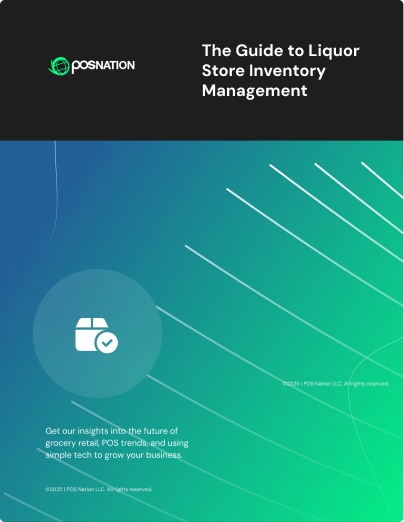Ever walk in, check your shelves, and realize your top-seller is out, while slow movers are gathering dust? If this keeps happening, it’s a sign your inventory process needs a tune-up.
An occasional missing item is expected. But if you’re constantly running out, overordering, or sitting on old stock, it’s costing you cash and customer trust — something no small retailer can afford.
Inventory management methods help you make better decisions about what to stock, when to reorder, and how to reduce waste. Explore eight inventory management strategies for small businesses — plus examples for convenience stores, liquor stores, hardware shops, and specialty retailers.
1. FIFO (First In, First Out)
FIFO moves your oldest inventory out the door first — perfect for anything with a shelf life, like snacks, dairy, or over-the-counter medications. This inventory management method reduces spoilage, cuts losses, and shows customers they can count on your products to be fresh.
Example: In a convenience store, staff restocks the cooler by pulling yesterday’s milk and sandwiches forward and placing today’s batch behind — so the oldest items sell first and nothing gets forgotten in the back.
2. LIFO (Last In, First Out)
LIFO sells the most recently purchased items first. It’s rarely used in retail for shelf rotation, but it’s a common accounting method. When prices rise, LIFO assigns higher-cost goods to each sale, which can reduce reported profits and result in lower taxable income.
It allows businesses to match current costs with ongoing sales, offering a more immediate reflection of rising supplier expenses.
Example: A hardware store using LIFO records screw sales based on the most recent purchase price, keeping financials in line with supplier cost increases — even if older inventory remains on the shelves.
3. Just In Time (JIT)
The Just In Time (JIT) inventory management technique keeps your inventory lean by ordering only when you need stock — not in advance. This lowers storage costs and helps avoid holding unsold items. However, it depends on reliable vendors and accurate sales data to avoid stockouts.
Example: Vape shops using JIT review weekly sales reports to identify fast-selling flavors, then place targeted restock orders based on that data — avoiding cluttered storage and matching inventory with real demand.
4. Economic Order Quantity (EOQ)
EOQ calculates the ideal order size using your sales rate, storage costs, and ordering expenses. It helps you avoid frequent reorders that raise costs or large bulk purchases that tie up cash and crowd your shelves.
Example: Liquor stores use EOQ to stock holiday wine — ordering enough to handle the rush without filling the stockroom with slow-moving cases or risking leftover inventory after the season.
5. Average Costing
Rather than tracking every price change, average costing assigns a consistent value to your inventory based on the average cost across multiple purchases. It’s an inventory management method that simplifies pricing and reporting, helping stores that restock often and don’t want every new invoice changing their shelf prices or skewing their margins.
Example: Hardware stores buy fasteners for $10, $12, and $14 per box. Instead of tracking each cost separately, it averages the price and uses that to set retail pricing.
6. Cycle Counting
Cycle counting is a less disruptive inventory management method used in busy stores where taking a full inventory each day isn’t realistic. Instead of shutting down to count everything at once, you check different store zones regularly — daily, weekly, or monthly — depending on how fast the items move.
Example: Tobacco stores count a few high-volume items — like cigars or vapes — weekly, and rotate through the rest monthly.
7. ABC Analysis
ABC analysis helps you prioritize your time and inventory budget by ranking products based on their impact. Instead of treating all items equally, you group them into A, B, and C categories, so you’re not wasting energy on low-demand items while high-margin products go unchecked.
- Track A items closely: Focus on high-value or high-margin products that need frequent attention.
- Review B items regularly: Monitor steady sellers to keep inventory levels consistent.
- Check C items occasionally: Limit time spent on low-cost or slow-moving products.
It’s an ideal system for retailers with large catalogs who want to focus their time and attention where it matters most.
Example: A liquor shop checks expensive bourbons weekly (A), reviews midrange vodkas monthly (B), and only reorders mixers (C) as needed.
8. Perpetual Inventory System
With a perpetual inventory system, stock levels update in real time as items are scanned or sold — no spreadsheets, no end-of-day guesswork. It’s powered by your point of sale (POS) system, helping you avoid errors caused by outdated counts.
Perpetual systems also give you better data for forecasting, since you’re working with up-to-the-minute numbers instead of yesterday’s estimates.
Example: Every time a soda or candy bar is sold at a convenience store, the POS system updates inventory instantly.
Find the Right Inventory Management Method for Your Business
There’s no one-size-fits-all approach to inventory control. The best inventory management method is the one that matches how your store operates — from the types of products you carry to how your team works day to day.
POS Nation helps small businesses take control of their inventory with software tailored to retail industries like tobacco, liquor, convenience, and hardware. Whether you need FIFO tracking, real-time updates, or tools for JIT restocking, we connect you with inventory management software that fits.
With features like cloud access, AI-powered tools, integrated e-commerce, and 24/7 support, customized POS tools simplify every part of your daily operations.
Are you looking for a way to reduce waste, stay stocked, and simplify reordering? Schedule your demo today to see how POS Nation supports your store’s inventory goals with tools that match your workflow.





